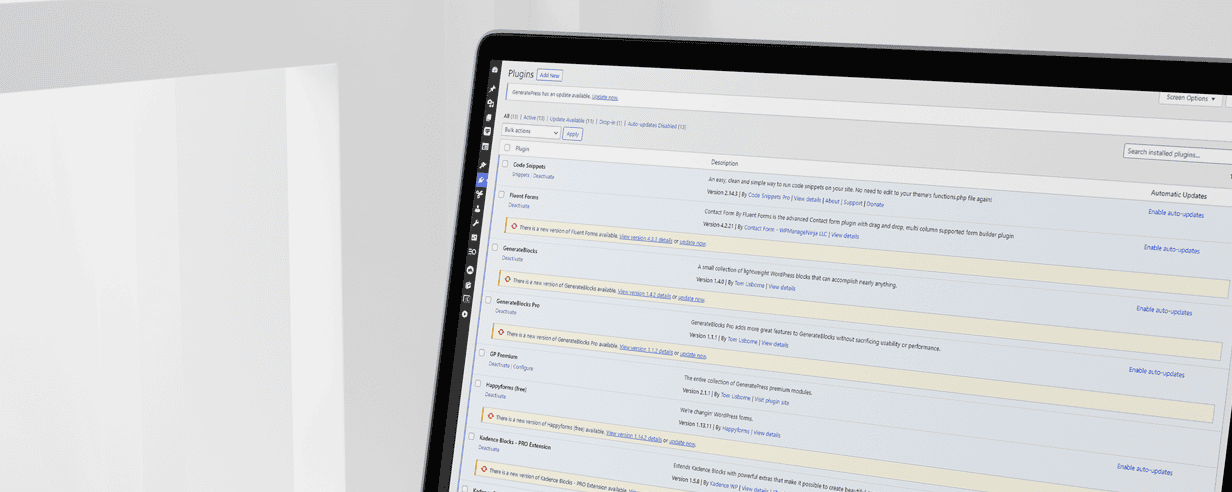This spring my wife and I went to a hot tub expo to look at hot tubs…
Hang tight, I haven’t lost my mind, I’m making a point.
We walked around the showroom floor for a good 15 to 20 minutes before admitting to each other that we had no clue what we were looking for.
Neither of us know the first thing about hot tubs… And without any frame of reference on which ones were “good” (or would be good for us), the only thing we could compare them on was looks and price.
Those things are important, but they are hardly the kind of thing you want to base your decision on when you’re going to be dropping five or ten grand.
Thankfully we were able to escape before the salespeople could mob us — I prefer to avoid situations where I am obviously ignorant in public. We were simply not in a position to buy a hot tub that day.
On the drive home, it dawned on me that the situation I found myself in was probably not unlike the way a lot of people feel when they reach out to me for a website.
The internet is far from new, but most people have never bought a website before, and they simply don’t know what to look for.
The internet is far from new, but most people have never bought a website before, and they simply don’t know what to look for.
Browsing portfolios and agency websites to try and find the right developer is hard to do when all of you have to go on is looks and price. And like a hot tub, you aren’t going to want to base your decision on those things alone.
If what I’m saying feels like I’m talking directly to you — then you’re in the right place.
Through this article we’re going to be covering what components are important for a website to be successful and the things you can be looking for when shopping for a developer for your next project.
We got a lot to cover, so let’s dive in!
Understanding Your Website’s Purpose

In a perfect scenario, your website will provide value to your visitors and support your business’s goals for the website existing in the first place.
But who are your visitors and what are your goals?
It’s a really big question, and websites can have many different purposes…
It may be an online store that relies on direct sales, it could be a blog that helps you build authority in your industry, it might just be informational to promote your services — or all of those things.
And this is exactly why so many “templated” websites fail. With a template, you make decisions in the wrong order — first choosing a look and layout, then trying to morph it into something that fits your needs.
In order to develop a website that will be a successful investment for your business, you’ll need to have a clear answer for these two questions; Who is your website for? And what are your goals?
When you know who you’re making the website for, and what it’s purpose is you’ll be able to make better decisions on the look, functionality, and scope of your project to help you meet your goals.
Who is your website for?
One mistake a lot of people make (especially people who DIY their website) is making design and functionality choices based on their own taste. But your website isn’t for you — it’s for your visitors!
A website that is planned and built with your customer’s needs in mind is always going to be more successful — even if it’s not the fanciest or extravagant thing.
In order to start thinking about who your website is for, ask yourself these questions:
- Who are your customers?
- Why are they visiting you online?
- What will they want to accomplish on your website?
- What’s important to them?
- What kinds of things do they find attractive?
What are your goals?
Of course, you aren’t building a website for charity and goodwill — you want to get a return on investment.
So, what actions do visitors on your website need to take in order for your website to be valuable?
Goals might include making direct sales, collecting contact information, or simply informing your visitors about the products and services you offer.
But if you don’t clearly define your goals before the project starts, you’ll have no way to measure whether or not it’s successful or not.
A good website provides its visitors with exactly what they came for while simultaneously accomplishing the business objectives it was built for.
Top to Bottom Consistency
When it comes to design, a lot of it comes down to taste. You might like the look of Ling’s Cars website, while others will wonder who on earth would think that’s okay!
Trends come and go, but the biggest factor when it comes to having a pleasing design is consistency — no matter the style or aesthetic.
First, consistency means being consistent with your brand. Of course, you’ll want your website colors and typography to match your logo & branding, but it goes further than that.
You want consistency in your tone of voice, your point of view, and your personality.
You want consistency in your tone of voice, your point of view, and your personality.
Companies often, inadvertently, create confusion by creating marketing pieces with little to no cohesion. If your website, billboard, storefront, and business cards all look different, then customers are going to have a hard time recognizing you and remembering who you are.
Brands stick in our minds through consistency. You don’t have to see the word “McDonalds” to know you’re looking at anything they produce (from the building to the hamburger).
Beyond brand consistency, it’s important that the elements and theme of your website are consistent throughout.
Nothing will kill a design faster than inconsistent spacing, mismatched photography, or misalignment.
You might not consciously pick up on these things — but your subconscious does, and it drives it nuts. We crave consistency from a cerebral level. While many design preferences are subjective — consistency isn’t one of them.
Even the most simplistic of designs can be extremely effective — so long as they are consistent throughout — from top to bottom.
Ease of Use

You’ve probably heard the idiom “less is more” — and it’s certainly true with websites.
Though you and your web development partner will spend hours combing through every single pixel on your website, that’s not how visitors are going to interact with it.
In fact, their goal is likely going to be visiting your website, finding what they need, and taking the next steps (whatever those may be) as quickly as possible.
Websites shouldn’t be a complex puzzle your users need to solve — but some sure feel that way!
If you make your website overly complex, uniquely bizarre, or difficult to navigate, then people won’t stick around.
There are standards (like a logo in the top left corner of your website) for a reason. By understanding and following these standards, you’ll create an experience that visitors will intuitively know how to use.
I’m not sure Einstein was talking about websites when he said “Everything should be made as simple as possible but not simpler”, but he hit the nail on the head.
Simplicity isn’t always easy to achieve — it often requires more thought and foresight than creating something complex.
Creating a frictionless experience for your visitors ties back into understanding your website’s purpose. It’s much easier to create a website with a great user experience when you know who you’re building your website for, and what you want them to do — anything beyond that is wasted time and money.
Accessibility
Unless you are living with a disability, you might have not considered this before — but the internet poses significant challenges to people with all kinds of disabilities.
Though there are many kinds of disabilities that affect the way people use the web, one of the easiest to understand is blindness or visual impairment.
Visual disabilities might result in people needing to navigate your website using their keyboard and a screen reader. Unless your website has been built with this in mind, it could be impossible for them to make their way through your website (and ultimately become your customer).
According to WHO, 15% of the world’s population has some sort of disability. This means around 15% of your website visitors might have a disability that prevents them from being able to fully use your website.
Excluding people with disabilities from being able to use your website (and losing 15% of your potential customers) is not only a poor business decision, but in some cases it’s illegal.
Unfortunately, regulations (at least here in the U.S.) aren’t always clear as to what needs to be done and who it applies to, but there are standards your website can adhere to in order to provide the best experience possible for all users.
Accessibility is becoming more and more important, and it’s something you’re going to want to consider on your website.
Performance Optimization

Raise your hand if you love waiting for ages for a website to load… How about when you open something on your phone and suddenly all the content shifts around and you inadvertently click an ad?
No one likes a slow website — including Google who in June of 2021 has officially made the performance of a website a determining factor in how it ranks in search results.
But just how impatient are website visitors? If your website takes just 4 seconds to load, the probability of people waiting is only about 10% — the rest are gone.
Between search engine optimization and user experience — the performance of your website is a critical factor in its success.
Between search engine optimization and user experience — the performance of your website is a critical factor in its success.
Yet, even knowing these statistics, most websites still don’t load in the “tolerable” range of 2-3 seconds. This is largely the result of today’s DIY tools which make it easier to build a website, but make concessions in performance in order to do so.
If you want to test a website’s speed, put the address of a website into Google’s PageSpeed tool, which will give it a grade from 0 to 100 and color-coded in red (bad), yellow (average), or green (good). Most websites will not pass this test — but you don’t want yours to be one of them.
Having a fast website isn’t necessarily more expensive — but it can have drastic effects on the value of your website. There are many factors to consider (from hosting to codebase) when optimizing the performance of a website and best results typically come from developers with more experience and a good understanding of website performance.
Compliance
Compliance is often overlooked because it’s not something most people can pick out (like you may be able to spot a poor design) — but that doesn’t mean its any less important.
You might not realize it, but websites do have to comply with certain laws and regulations across the world. Failure to comply with these laws can not only cost you in fines, but businesses can find themselves with a day in court having to explain to a judge why their website isn’t compliant.
Ain’t nobody got time for that!
Your website will most likely need a Privacy Policy and Terms of Service, but it may need to comply with GDPR (a European law governing the transfer of data — yes, it applies to businesses in the US too!). A court recently found Google Analytics in violation of GDPR, which can result in up to 20-million-dollar fines. Considering Google Analytics is used on around 80% of websites online, there’s a lot of money to be made, and plenty of greedy lawyers who will be chasing these easy paydays.
Make sure your web developer talks to you about compliance and what kind of precautions are taken to ensure your website is compliant with local, federal, and international laws.
Completed Metadata
Metadata isn’t something most people will notice from the front end of the website, but it’s what robots (like the Google bot who makes decisions about how your website ranks and what it ranks for) read.
This comes in the form of page titles, meta descriptions, alt tags, and schema (to name a few).
Without being too technical, it’s the data about your data — and if you want your website to get found in search engines, it’s extremely important.
After auditing hundreds (possibly thousands?) of websites, I’ve realized how many websites fail to input or complete the metadata on a website.
Not just DIY websites either — even ones built by big (and expensive!) agencies.
You don’t need to become an expert in website metadata (leave that to nerds like me!), but if you want a good website, then you’re going to want to make sure your metadata is complete.
If you’re curious about a website’s metadata, or just want to become vaguely familiar, Hey Meta provides a simple interface that will display any website’s metadata when you enter the address.
Content: Created for Humans (and Optimized for Bots)
Content is everything that goes on your website — the written word (or “copy”), images, graphics, videos, charts, documents, etc.
It’s arguably the most important part of your website — and one of the easiest to get wrong.
You want your content to draw your visitors in, learn more about your company, and ultimately become your customer.
A lot of business owners decide to write copy on their own — primarily for budgetary reasons… But writing effective website copy is an art form (and profession!) of its own.
Whether or not you should write copy yourself is an argument for another day, but no matter which way you decide your content needs to be created for humans.
That might seem like an odd statement to make — but hear me out.
Because of how important search engine rankings are, people have spent decades trying to decode Google’s algorithm for making ranking decisions. That work led to a massive shift in creating content that was specifically written to make the Google Gods happy (at the expense of users).
Thankfully, Google has gotten wise to those tactics and made a massive shift in how they determine where websites rank. Simply put, your website content should be written to give the best user experience possible.
However, that doesn’t mean you can ignore all the technical factors that still affect ranking.
Strategically planning the content you develop, the keywords or keyphrases you use, proper HTML structure, and at least a dozen other factors are still crucial.
Your content will be most effective if it’s written for humans and optimized for bots.
Usable Across All Devices

There was a time when there was a “standard” size to design a website. You could plan everything out with pixel precision and everyone would have the same experience viewing the website.
But those days are long gone!
Today people are browsing the web on devices as small as a watch and as big as a widescreen TV — and everything in between.
What size screen will your visitors be using when they come to your website? It could literally be anything — so your website must be built in a way that accounts for that.
In today’s terms, that means “responsive design” where the content of the website automatically (or “automagically” as I like to call it) adjusts and adapts to fit on the user’s display.
Thankfully most websites are built like that today, and even DIY builders account for the massive amounts of device sizes available.
But just because it’s standard doesn’t mean you can overlook it.
A page that isn’t “mobile-friendly” is a quick way to lose visitors and rankings.
A page that isn’t “mobile-friendly” is a quick way to lose visitors and rankings.
When looking through portfolios or websites for inspiration, trying viewing them from different devices (desktops, laptops, tablets, phones) and see how the layout of the website changes as you change the size of the screen.
A well-built website will provide a great experience no matter the screen size.
Security & Maintenance
Like everything online, it’s important to keep your website safe and secure — which can be a constant battle. Experiments have shown that hackers can start hitting a website within hours of it first being published online — and they never stop.
When most people consider website security they immediately think about eCommerce websites, which could be a way to steal credit card numbers and personal information.
Ecommerce does have an enhanced security thread, but any website can be a target..
Most website hacks on small businesses have nothing to do with stealing money — instead, they are stealing traffic.
A common malware tactic is to redirect visitors from your website to other websites (typically websites that are not safe for work or sell illegal substances), or show ads for similar types of businesses right on your website.
It doesn’t matter how small or insignificant your website is — it’s a numbers game. The hackers don’t care about your website, specifically — they are just trying to infect as many websites as possible.
These breaches can be a nightmare to deal with and tricky to get rid of.
There are plenty of precautions website owners can take to mitigate their risks, including; security software, firewalls, frequent backups, keeping website software up to date, and more. With the proper systems in place you can thwart most attacks before they ever take place.
It’s significantly cheaper to invest in the right software and systems to prevent attacks than it is to clean up after they’ve taken place.
OGAL Web Design offers completely website management packages that take care of these things (and more!) for you so you don’t have to stress over web security.
Continual Measurement & Improvement

One of the greatest benefits to digital marketing is that nearly everything can be tracked, measured, and continually improved over time.
Your website isn’t “finished” after you publish it — it’s born… After launch you need to be dedicated to nurturing it and seeing it grow.
If you plan your website strategically, and have an experienced partner helping you along the way, you’ll be off to a great start — but it’s all theory until you have actual visitors interacting with your website.
Once you start measuring the use of your website you can use that data to make informed decisions on ways to improve your website to increase conversions.
Analytics software can give you deep insights into how visitors are using your site, including; how many visitors you get, how they find you, what pages they visit, where they get stuck, and the content that’s most important to them.
Not only does ongoing tweaks to your website make it more effective, an active website builds trust with users and search engines alike.
If visitors find information on your website that is obviously out of date (like your most recent blog post being a year old), they start to question if any of the information on the website is current.
The same goes for Google — who wants to promote websites with the most accurate and up to date information possible. Through metadata, Google can see when pages have been published and/or modified, and will give favor to websites that are updated frequently.
And besides all of those benefits to keeping your website updated — things change! The products or services you offer today might look differently 6 months or a year from now. Unlike printed materials that have to be thrown away when the information becomes outdated, your website can be easily modified and updated at a moments notice — and it should be!
Easy to Update and Modify Over Time
Because keeping your website up to date is so important, it’s critical that you build a website that can be easily updated as time goes on.
If making updates to your website is expensive or cumbersome, you’re unlikely to do it and your website can start collecting dust.
If you’re hiring someone to build your website, it’s important to ask about how updates and modifications work after the website is launched. Many agencies build websites with these things in mind, and conversations like this can ensure that the most important aspects to keep current are easy and user friendly for even novice users to handle.
But that’s not always the case. Websites can be constructed thousands of different ways, and it’s not uncommon to find a website that only he original developer knows how to make changes to.
This is one of the reasons why WordPress (what we use here at OGAL Web) has become the most popular content management system (CMS) on the planet. Not only can websites be easy for most people to make small changes to (like copy, images, videos, etc.), but because it’s such a popular platform (powering around ⅓ of the websites on the internet) you don’t have to look hard to find an expert that can help you — even if it’s not the person who originally built the website.
When your car breaks down, you don’t want to have to track down the team that built it — you want to be able to take it into any shop who can make repairs. The same is true for your website.
Keeping the information on your website current should be an asset to your business, not a burden. Ensuring you have a website where making updates is easy is something that will continue to provide value long after the website is launched.
Spotting a “Good” Website
As you’ve learned going through this article, a “good” website might not always be easy to see from browsing the front end… Things like metadata, security, and the ability to make changes easily are something that might be be apparent when visiting a website — but are extremely important to the website’s success.
No two website are alike — they all have different goals, audiences, and strategies to consider. A good website for your will be one that speaks to your target audience, guides them to your goals, is consistent, easy to use (for people of all abilities), loads quickly, has the right metadata in place, displays beautifully across all devices, is secure and properly maintened, and is constantly evolving to meeting the challenges of tomorrow.
If you’d like to talk about creating a website that does all of those things (and more!) for your business, then I’d love to have a chat with you.
My project inquiry form takes just a few minutes to fill out and we can schedule a meeting to discuss your project in detail — no strings attached.
If you want to learn more about planning a website project, check out my Website Buyers Guide which will dive in deep to website planning and scoping.




